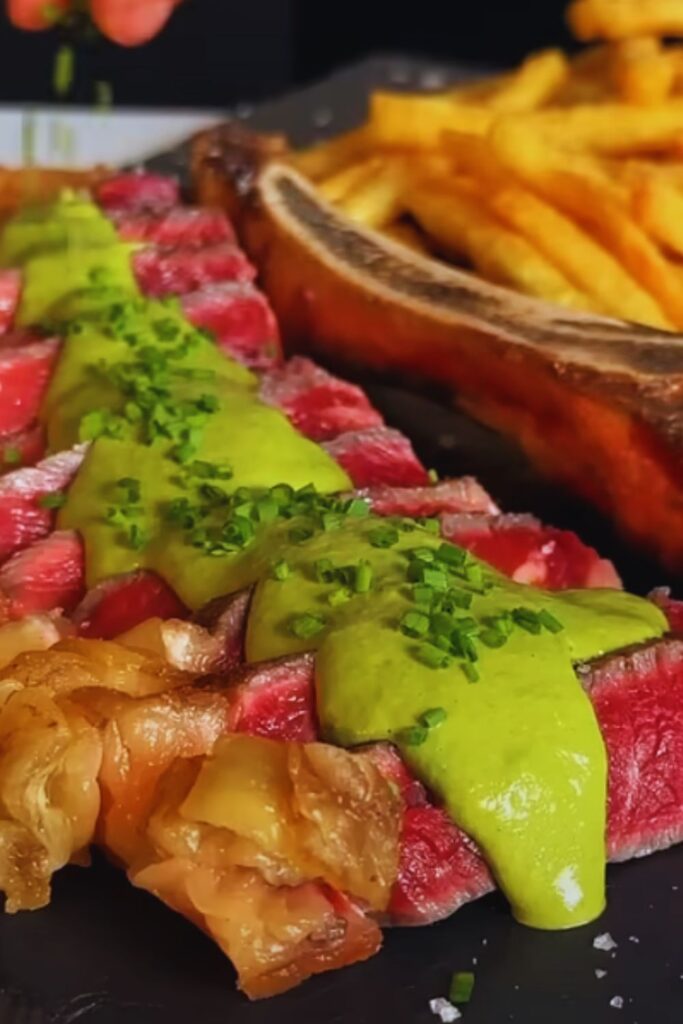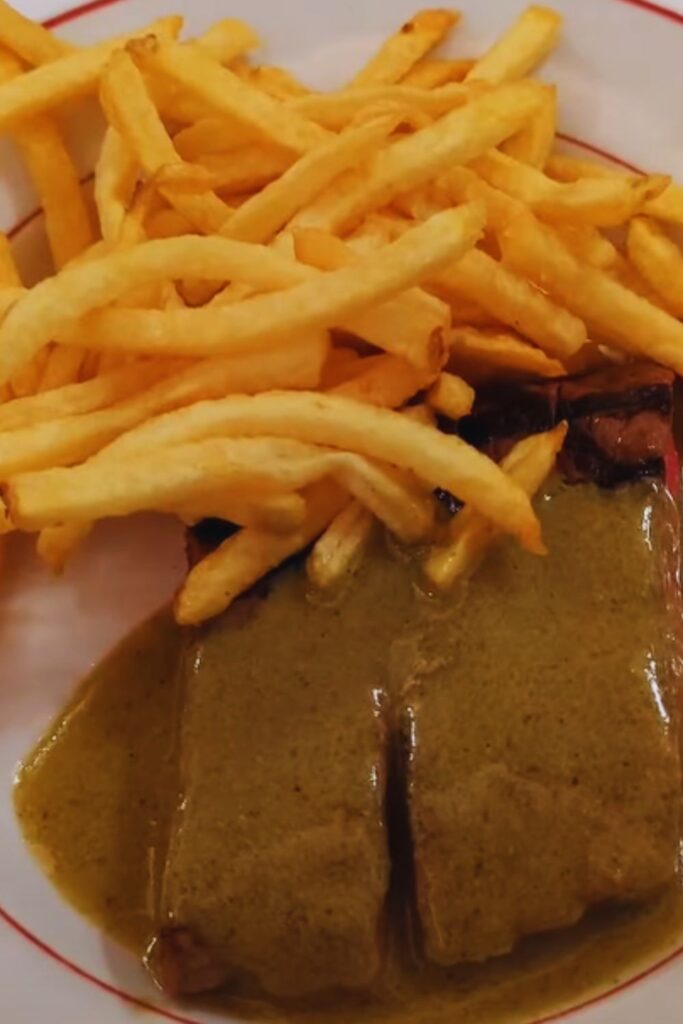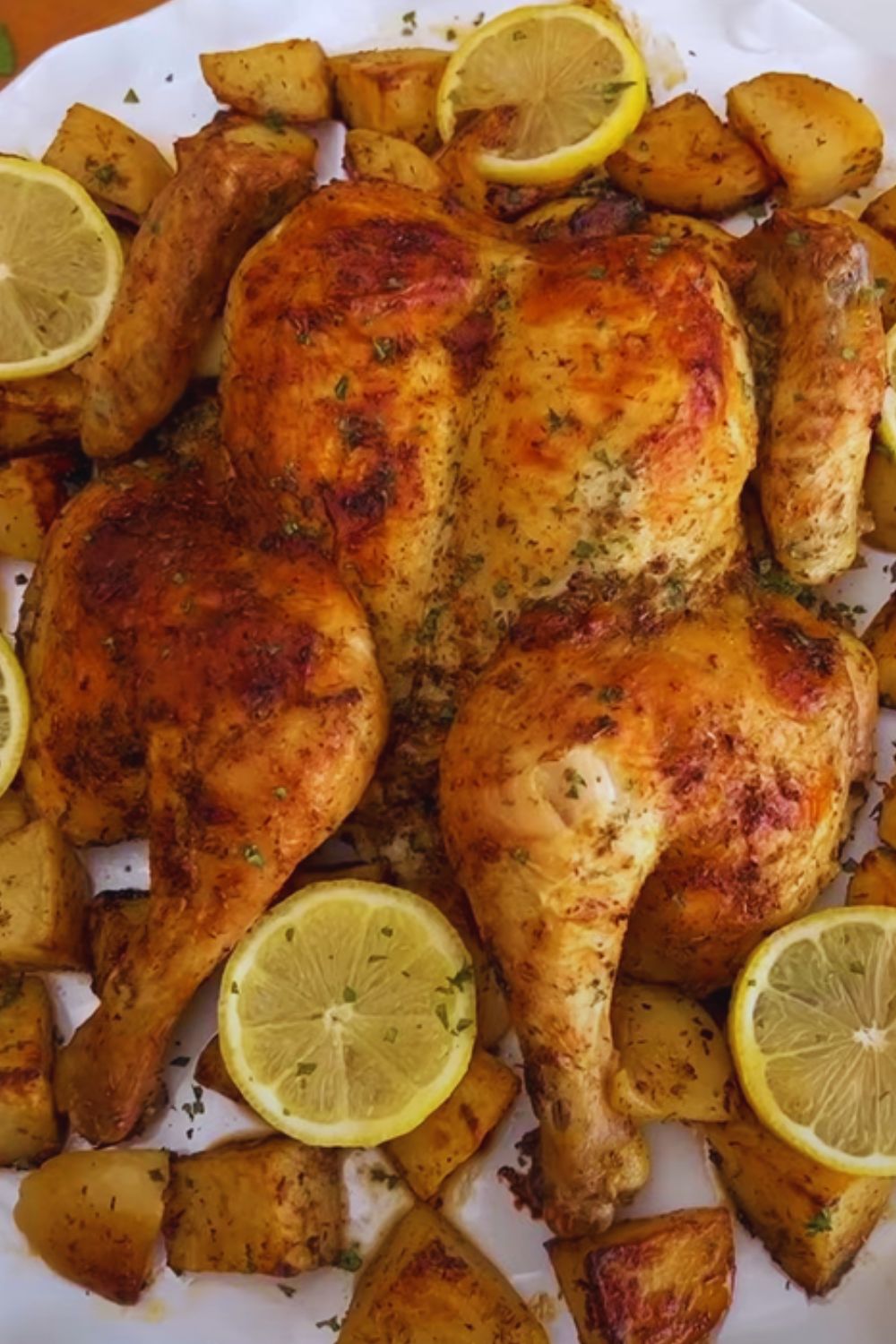There’s something undeniably magical about a perfectly executed plate of steak frites. This classic French bistro dish—translating simply to “steak and fries”—might seem straightforward, but achieving restaurant-quality results at home requires attention to detail and technique. I’ve spent years perfecting my own version, and today I’m sharing everything I’ve learned about creating this iconic comfort food in your own kitchen.
What Makes Steak Frites Special?
Steak frites holds a special place in culinary tradition. It’s the quintessential bistro dish that embodies French casual dining at its finest. While deceptively simple—just a well-cooked steak alongside crispy golden fries—the magic lies in the execution. The steak should have a perfect sear while remaining juicy inside, and the frites must be crispy on the outside while maintaining a fluffy interior.
I first fell in love with this dish during a trip to Paris, where I found myself returning to the same corner bistro three times in one week just to experience their impeccable steak frites again and again. The waiter eventually recognized me and laughed, saying “Ah, the American who loves our steak frites!” It was worth being teased—the dish was that good.
Choosing the Right Cut
The foundation of exceptional steak frites begins with selecting the right cut of beef. While traditional French preparations often use entrecôte (ribeye), several other cuts work beautifully:
- Ribeye (Entrecôte): Rich, well-marbled, and full of flavor. My personal favorite for its balance of tenderness and beefy taste.
- Strip Steak (New York Strip): Excellent balance of tenderness and flavor with a firmer texture than ribeye.
- Hanger Steak (Onglet): More affordable with intense beef flavor, though slightly chewier.
- Flank or Skirt Steak: Budget-friendly options that deliver great flavor when sliced against the grain.
When selecting your steak, look for:
- Good marbling (thin white streaks of fat throughout the meat)
- Bright red color (avoid gray or brown discoloration)
- Thickness of at least 1-inch (2.5cm) for easier cooking to desired doneness
- Dry-aged beef if available and within budget
I typically opt for ribeye when preparing steak frites at home. While it’s pricier than other cuts, the marbling creates a self-basting effect that helps keep the meat juicy during cooking. That said, a well-prepared hanger steak can rival more expensive cuts at a fraction of the cost.
The Secret to Perfect Frites
True French frites aren’t simply thrown in a fryer and forgotten. They require a specific technique to achieve that distinctive crispy-outside, fluffy-inside texture. The traditional method involves double-frying—a technique I was initially intimidated by but now swear by.
Choosing the Right Potato
Russet potatoes (also called Idaho or baking potatoes) are ideal for frites because of their high starch content and low moisture. In France, they often use a variety called Bintje, but Russets make an excellent substitute in North America. Yukon Golds can work in a pinch, though they tend to be slightly waxier.
The Double-Fry Method
The double-fry method is non-negotiable for authentic frites:
- First fry (blanching): Cook at a lower temperature (325°F/163°C) for 5-7 minutes to cook the potato through without browning
- Rest period: Allow the potatoes to cool and dry for at least 15 minutes (or refrigerate for up to several hours)
- Second fry (crisping): Fry at a higher temperature (375°F/190°C) until golden and crispy
This method ensures the interior cooks to fluffy perfection while the exterior develops a satisfying crunch. I learned this technique from a French chef who explained that the rest period between fries is crucial—it allows moisture to escape from the potato, resulting in a crispier final product.

My Foolproof Steak Frites Recipe
Now that we’ve covered the fundamentals, let’s dive into my step-by-step approach to creating restaurant-quality steak frites at home.
Ingredients
For the Steak:
- 2 ribeye steaks (about 12oz/340g each), 1-inch thick
- 2 tablespoons high-smoke-point oil (grapeseed, avocado, or clarified butter)
- 4 tablespoons unsalted butter
- 4 garlic cloves, crushed but left whole
- 4 sprigs fresh thyme
- Coarse sea salt and freshly ground black pepper
For the Herb Butter (optional but recommended):
- 4 tablespoons unsalted butter, softened
- 1 tablespoon finely chopped parsley
- 1 teaspoon finely chopped tarragon
- 1 small garlic clove, minced
- 1 teaspoon lemon zest
- Pinch of sea salt
For the Frites:
- 2 pounds (900g) Russet potatoes
- 2 quarts (2L) vegetable oil or beef tallow for frying
- Sea salt to taste
For the Classic Sauce (Optional):
- 1/4 cup (60ml) heavy cream
- 2 tablespoons green peppercorns in brine, drained
- 1 tablespoon Dijon mustard
- 1 tablespoon brandy or cognac (optional)
- 1/2 cup (120ml) beef stock
- 1 teaspoon butter
Method
Preparing the Herb Butter (make ahead)
- Combine all herb butter ingredients in a small bowl and mix thoroughly
- Transfer to a piece of parchment paper and roll into a log shape
- Refrigerate for at least 30 minutes or until firm
- Slice into medallions when ready to serve
Preparing the Frites
- Peel potatoes and cut into batons approximately 1/4-inch (6mm) thick
- Rinse thoroughly in cold water to remove excess starch
- Soak in cold water for 1-2 hours (this removes additional starch for crispier fries)
- Drain and pat completely dry with paper towels (moisture is the enemy of crispiness)
- Heat oil to 325°F (163°C) in a large, heavy-bottomed pot or deep fryer
- Working in batches to avoid overcrowding, blanch potatoes for 5-7 minutes until soft but not browned
- Remove with a slotted spoon and place on a wire rack set over a baking sheet
- Allow to cool completely, at least 30 minutes (or refrigerate for several hours)
- Increase oil temperature to 375°F (190°C)
- Fry potatoes again in batches until golden brown and crispy, about 3-4 minutes
- Drain on fresh paper towels and season immediately with salt
Cooking the Perfect Steak
- Remove steaks from refrigerator 30-45 minutes before cooking to bring to room temperature
- Pat steaks completely dry with paper towels (moisture prevents proper searing)
- Season generously with coarse salt and freshly ground pepper on both sides
- Heat a cast-iron skillet over high heat until smoking hot
- Add oil to the pan and swirl to coat
- Carefully place steaks in the pan and cook without moving for 3-4 minutes to develop a crust
- Flip steaks and add butter, garlic, and thyme to the pan
- Tilt the pan slightly and use a spoon to baste the steaks with the butter mixture continuously
- Cook for another 3-4 minutes for medium-rare (adjust time for desired doneness)
- Transfer to a cutting board and let rest for at least 5 minutes before serving
For the Optional Sauce
- After removing steaks, keep 1 tablespoon of fat in the pan and discard the rest
- Add green peppercorns and cook for 30 seconds
- Add brandy if using (stand back in case it flames up) and let reduce by half
- Add beef stock and reduce by half again
- Stir in cream and Dijon mustard
- Simmer until slightly thickened, then whisk in butter
- Season to taste
Assembly
Place the frites on warm plates, add the steak alongside, and top the steak with a medallion of herb butter. If using the sauce, drizzle it around the steak or serve in a small ramekin on the side. Garnish with a small handful of flaky sea salt and a sprig of fresh herbs if desired.

Perfecting Your Technique: Tips and Tricks
Over the years, I’ve discovered several techniques that elevate steak frites from good to exceptional:
For the Steak
- Dry-brining: For extra flavor and tenderness, salt your steak and leave it uncovered in the refrigerator for 24 hours before cooking. This creates a mini dry-aging effect.
- The finger test: Learn to gauge doneness by comparing the firmness of the steak to different parts of your hand:
- Thumb and index finger together: rare
- Thumb and middle finger: medium-rare
- Thumb and ring finger: medium
- Thumb and pinky: well-done
- Carryover cooking: Remember that meat continues cooking after being removed from heat. Pull your steak about 5°F (3°C) before your target temperature.
For the Frites
- Oil temperature is crucial: Use a thermometer to maintain precise temperatures during both frying stages.
- Cut consistently: Uniform sizes ensure even cooking.
- Beef tallow option: For truly authentic flavor, try using beef tallow instead of vegetable oil. The difference is remarkable.
- Keep them warm: If making a large batch, keep finished frites warm in a 200°F (93°C) oven on a wire rack until ready to serve.
Cooking Temperatures for Steak
Understanding steak doneness temperatures is essential for consistently perfect results:
| Doneness Level | Internal Temperature | Description | Rest Time |
|---|---|---|---|
| Blue | 115°F (46°C) | Very red and cold center | 5 minutes |
| Rare | 125°F (52°C) | Very red, warm center | 5-7 minutes |
| Medium-Rare | 135°F (57°C) | Red, warm center | 5-7 minutes |
| Medium | 145°F (63°C) | Pink center | 7-10 minutes |
| Medium-Well | 150°F (66°C) | Slightly pink center | 7-10 minutes |
| Well-Done | 160°F (71°C) | Little to no pink | 10 minutes |
I strongly recommend using an instant-read thermometer until you develop the confidence to judge doneness by touch. Remember to insert the thermometer horizontally into the center of the steak for the most accurate reading.
Troubleshooting Common Issues
Even experienced cooks occasionally encounter challenges when preparing steak frites. Here are solutions to common problems:
Steak Challenges
- Tough steak: Likely overcooked or not sliced against the grain. Use a meat thermometer and pay attention to grain direction when slicing.
- Gray exterior without proper searing: Pan wasn’t hot enough. Ensure the pan is smoking hot before adding the steak.
- Uneven cooking: Steak wasn’t at room temperature before cooking. Allow 30-45 minutes for the steak to come to room temperature.
- Chewy texture: Poor quality meat or wrong cut. Invest in higher-quality meat or choose a more tender cut.
Frites Challenges
- Soggy frites: Usually caused by frying at too low a temperature, overcrowding the fryer, or insufficient drying before frying. Use a thermometer, cook in small batches, and thoroughly dry potatoes.
- Frites browned but not crispy: Likely didn’t use the double-fry method or potatoes weren’t dried properly.
- Frites too dark or burnt tasting: Oil temperature too high. Use a thermometer to maintain proper temperatures.
- Frites greasy: Oil not hot enough or potatoes not dried properly before frying.
Serving Suggestions
While steak frites is delicious on its own, I like to complement it with:
- A small green salad with a sharp vinaigrette to cut through the richness
- Roasted garlic cloves
- Compound butter variations (blue cheese butter, anchovy butter, or truffle butter)
- Mustard selection (Dijon, whole grain, or horseradish mustard)
- A simple sauce like béarnaise or au poivre
For a complete bistro experience, consider starting with a classic French appetizer like onion soup or a simple country pâté.

Make-Ahead Components
When entertaining, I prepare certain elements in advance:
- Herb butter can be made up to a week ahead and stored in the refrigerator (or frozen for up to a month)
- Potatoes can be cut, soaked, and blanched (first fry) earlier in the day, then refrigerated until the final fry
- Sauce can be made a day ahead and gently reheated before serving
This approach allows me to focus on perfectly cooking the steak when guests arrive while still providing the full steak frites experience.
Nutritional Information
For those watching their intake, here’s a breakdown of what to expect from a typical serving of steak frites:
| Nutrient | Amount per Serving | % Daily Value* |
|---|---|---|
| Calories | 850-950 | – |
| Protein | 45-55g | 90-110% |
| Fat | 55-65g | 70-85% |
| Saturated Fat | 25-30g | 125-150% |
| Carbohydrates | 40-50g | 15-18% |
| Dietary Fiber | 3-4g | 11-14% |
| Sodium | 800-1000mg | 35-43% |
| Potassium | 1300-1500mg | 28-32% |
| Iron | 6-8mg | 33-44% |
| Vitamin B12 | 2-3μg | 83-125% |
*Percent Daily Values based on a 2,000 calorie diet
While steak frites isn’t a low-calorie dish, it provides significant protein, iron, and B vitamins. I consider it an occasional indulgence rather than an everyday meal.
Variations on Classic Steak Frites
While I adore traditional steak frites, several variations can keep this classic dish interesting:
Alternative Cuts and Preparations
- Steak Frites with Bavette (Flank Steak): Marinate the bavette for a few hours before cooking to tenderize and add flavor.
- Steak Frites with Filet Mignon: More expensive but incredibly tender. Cook for less time than fattier cuts.
- Steak Frites with Flat Iron: An economical option with excellent flavor. Cook to medium-rare for best results.
Frites Variations
- Truffle Frites: Toss hot frites with truffle salt or a small amount of truffle oil.
- Herb Frites: Add finely chopped rosemary or thyme to the salt before seasoning.
- Garlic Parmesan Frites: Toss hot frites with grated Parmesan cheese and garlic powder.
- Sweet Potato Frites: Use the same double-fry method but reduce temperatures by about 15°F.
Sauce Alternatives
- Béarnaise Sauce: A classic pairing featuring tarragon and white wine.
- Red Wine Reduction: Reduce good red wine with shallots and beef stock, then mount with butter.
- Chimichurri: This Argentinian herb sauce offers a bright, acidic counterpoint to rich steak.
- Roquefort Sauce: Melt blue cheese into warm cream for a decadent topping.
Frequently Asked Questions
What’s the best way to reheat leftover steak without overcooking it?
I recommend slicing leftover steak thinly and warming it gently in a pan with a splash of beef broth. This adds moisture without further cooking the meat. Alternatively, place the whole steak in a 275°F (135°C) oven until it reaches about 110°F (43°C) internally, then sear quickly in a hot pan to refresh the exterior.
Can I prepare steak frites for a large group?
Yes, though it requires planning. For the frites, complete the first fry in advance, then do the final fry just before serving. For the steaks, consider using the reverse-sear method: cook them in a low oven to about 15°F below your target temperature, then finish with a quick sear right before serving. This method gives you more control when cooking multiple steaks.
Is it worth investing in a deep fryer just for making frites?
While a dedicated deep fryer makes the process easier and safer, it’s not essential. A heavy-bottomed Dutch oven and a good thermometer work perfectly well. That said, if you make frites frequently, a fryer with temperature control can be a worthwhile investment.
What’s the best oil for frying the perfect frites?
Traditional Belgian frites are famously fried in beef tallow, which imparts incredible flavor. For a more neutral option, peanut oil has a high smoke point and clean flavor. Vegetable or canola oil works well too. Avoid olive oil, which has too low a smoke point for proper frying.
How can I make this dish healthier?
While steak frites will never be a low-calorie meal, you can make adjustments: opt for leaner cuts like sirloin, reduce portion sizes, oven-bake the frites tossed in a small amount of oil, or serve with a larger portion of vegetables and a smaller serving of steak and frites.
Why did my frites turn soggy so quickly after frying?
This typically happens if the potatoes weren’t dried thoroughly before frying or if the oil temperature was too low. Moisture is the enemy of crispness. Also, avoid covering hot frites, as trapped steam will soften them rapidly.
What type of potatoes should I avoid for making frites?
Waxy potatoes like red potatoes or new potatoes don’t make good frites. Their low starch content means they’ll never achieve that fluffy interior we’re looking for. Stick with starchy varieties like Russets.
Can I freeze the blanched frites before the second fry?
Absolutely! After the first fry, cool the frites completely, then freeze them in a single layer on a baking sheet before transferring to a freezer bag. You can fry them directly from frozen at 375°F (190°C) until golden and crispy. This is actually how many restaurants prepare their frites.
Final Thoughts
Mastering steak frites at home is an accomplishment worth celebrating. This seemingly simple dish requires attention to detail and proper technique, but the results are undeniably satisfying. The combination of a perfectly cooked steak alongside crispy, golden frites creates a meal that’s greater than the sum of its parts.
I hope this guide inspires you to try making this classic bistro dish in your own kitchen. Remember that practice makes perfect—each time you prepare steak frites, you’ll develop a better sense of timing, temperature, and technique. Before long, you might find friends and family requesting your signature steak frites over restaurant versions!
The beauty of steak frites lies in its honest simplicity. It doesn’t hide behind complex sauces or elaborate presentations—it’s just good beef and potatoes prepared with care and respect for the ingredients. In my view, that’s what makes it timeless.



